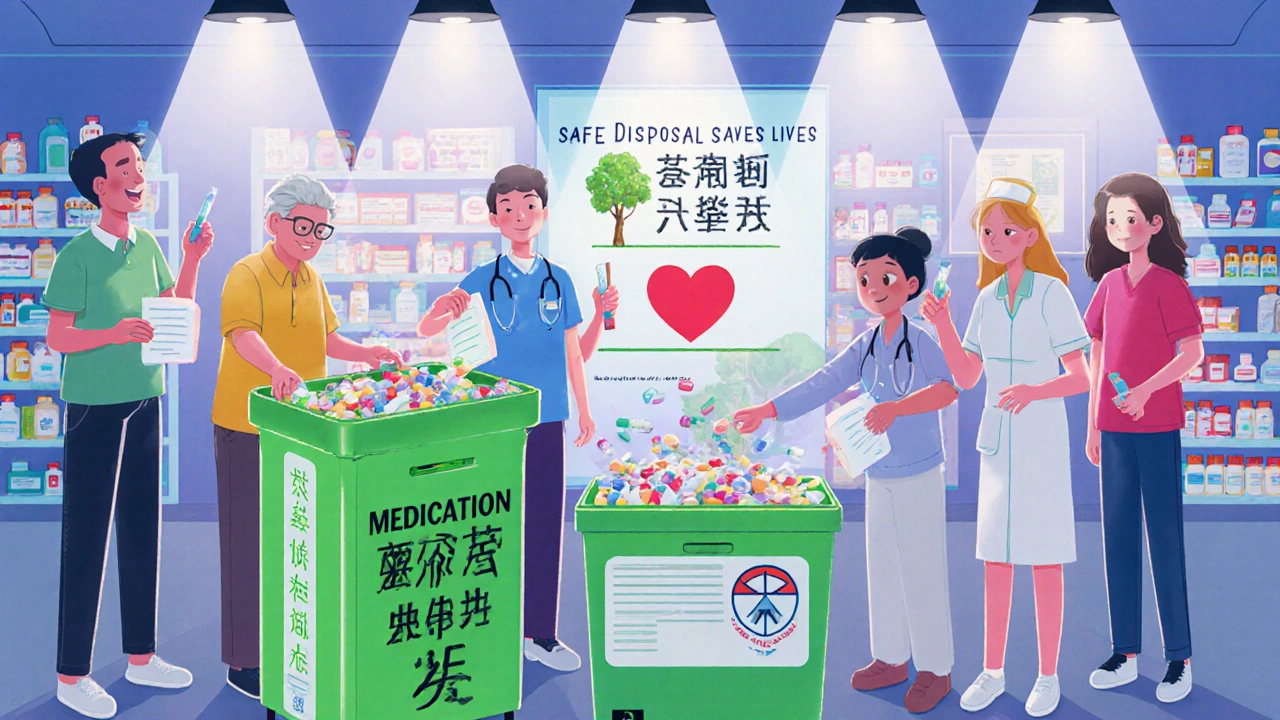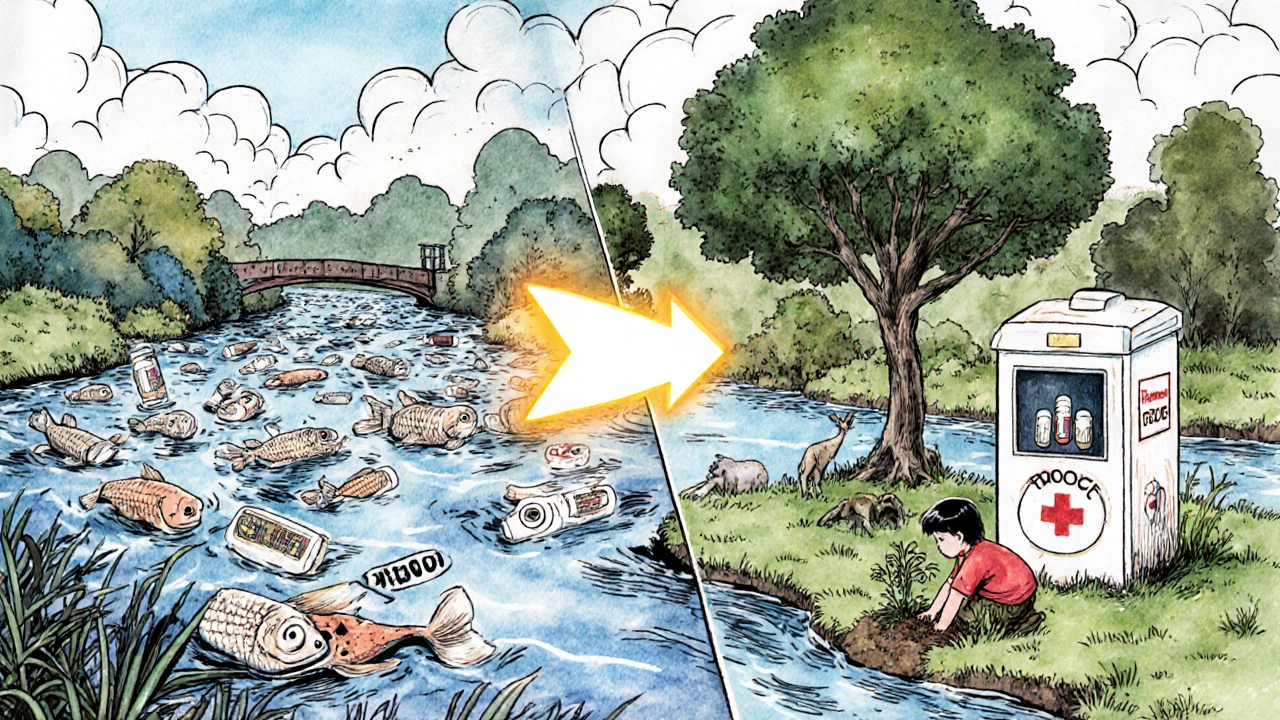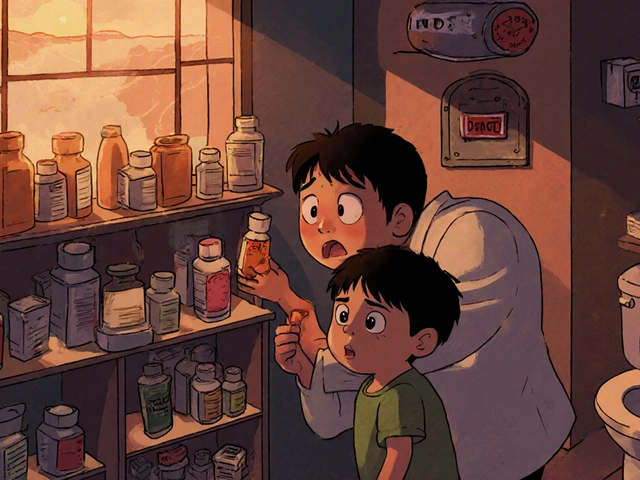Why Proper Medication Storage and Disposal Matters
Every year, millions of unused or expired prescriptions sit in bathroom cabinets, kitchen drawers, and medicine chests across the UK. Some are kept out of habit. Others are saved "just in case." But leaving pills lying around isn’t harmless-it’s risky. Children find them. Pets chew through bottles. Teens experiment. And when flushed down the toilet or tossed in the trash improperly, these drugs leak into water supplies, harm wildlife, and contaminate soil.
The UK follows similar guidelines to the US EPA and FDA, with strict rules on how to store and dispose of medicines. The goal is simple: keep people safe, protect the environment, and stop drugs from falling into the wrong hands. This isn’t just about following rules-it’s about preventing overdose, addiction, and pollution before they happen.
How to Store Medications Safely at Home
Where you keep your meds matters just as much as how you take them. Most prescription drugs should be stored in a cool, dry place away from sunlight and moisture. That means no more keeping them above the bathroom sink or in the kitchen near the stove.
- Temperature matters: Most tablets and capsules are fine at room temperature (between 68°F and 77°F / 20°C and 25°C). Some, like insulin or certain antibiotics, need refrigeration (36°F-46°F / 2°C-8°C). Always check the label.
- Lock it up: If you have controlled substances-like opioids (oxycodone, tramadol), benzodiazepines (diazepam), or stimulants (methylphenidate)-they must be stored in a locked box or cabinet. These drugs are highly addictive and often targeted by thieves or curious teens.
- Keep out of reach: Use high shelves or childproof containers. Even a child who can’t read can open a bottle if it’s within reach. Pet-proofing is just as important-dogs and cats can get seriously ill from even one pill.
- Don’t mix: Store different medications separately. Mixing them in one container makes it hard to tell what’s what, especially if labels wear off.
Many people don’t realize that heat and humidity can break down medicine. A pill left in a hot car or a steamy bathroom can lose its strength-or become dangerous. If your medication looks discolored, smells odd, or crumbles easily, don’t take it. Ask your pharmacist for a replacement.
What to Do with Unused or Expired Medications
Expired painkillers, leftover antibiotics, or old antidepressants shouldn’t sit around. But throwing them in the bin or flushing them isn’t the answer. Here’s what to do instead.
Best option: Use a take-back program. The safest way to dispose of any medication-especially controlled substances-is through a pharmacy take-back box or a police station drop-off point. In the UK, many community pharmacies offer free disposal services. You can find your nearest location through the NHS website or by calling your local pharmacy. These programs collect pills, patches, liquids, and even syringes (with caps on) for safe destruction.
If no take-back is available: Follow the FDA’s at-home disposal method:
- Take pills out of their original bottles.
- Mix them with something unappetizing-used coffee grounds, cat litter, or dirt.
- Put the mixture in a sealed plastic bag or container.
- Scratch out your name and prescription number on the empty bottle.
- Throw the sealed container in your household trash.
This method makes the drugs unappealing and unusable. It also prevents someone from digging through your trash and finding pills.

When Flushing Is Actually Allowed
Most people think flushing is never okay. But there’s an exception.
The FDA maintains a Flush List-a small group of medications that are so dangerous if misused that flushing is the safest option if no take-back is available. These include powerful opioids like fentanyl patches, oxycodone, and morphine, and one benzodiazepine: alprazolam (Xanax).
Why? Because even one pill can kill someone who didn’t get the prescription. If a child finds a fentanyl patch in the trash, it could be fatal. Flushing these drugs immediately removes the risk. Don’t flush anything else. Only use this method for drugs on the official list. Check the FDA’s website or ask your pharmacist if you’re unsure.
What Healthcare Workers Must Do Differently
Hospitals, care homes, and pharmacies have stricter rules. They can’t just toss pills in the bin or use home disposal methods. They’re legally required to handle pharmaceutical waste as regulated medical waste.
- Hazardous vs. non-hazardous: About 5-10% of pharmaceutical waste is classified as hazardous by environmental agencies. These include chemo drugs, certain antibiotics, and mercury-containing products. They must go to licensed incinerators.
- Controlled substances: Even if a drug isn’t hazardous, if it’s a controlled substance (like codeine or diazepam), it must be destroyed under strict documentation. Staff must record the quantity, date, and method of disposal. These records must be kept for at least three years.
- No sewer disposal: Flushing any pharmaceutical waste down the drain is illegal for healthcare facilities under UK and EU regulations. This rule prevents drugs from entering rivers and drinking water.
- Proper containers: Waste must go into leak-proof, puncture-resistant, clearly labeled bins. These bins are collected by licensed waste handlers-not regular trash trucks.
Many clinics struggle with the complexity. Nurses often don’t know which drugs are hazardous. A 2021 study found that 42% of UK healthcare workers felt unsure about disposal rules. Training is key. Every staff member needs to know the difference between a regular pill and a hazardous one.

Common Mistakes and How to Avoid Them
Even well-meaning people make errors. Here are the most common ones-and how to fix them.
- Mistake: Throwing pills in the recycling bin. Fix: Medications are not recyclable. Never put them in your blue bin.
- Mistake: Crushing pills before mixing them with coffee grounds. Fix: Crushing can release dangerous fumes or make the drug easier to misuse. Just leave pills whole.
- Mistake: Keeping old meds "just in case." Fix: Most drugs lose potency after a year. Some, like nitroglycerin, become useless or even harmful. Get rid of anything you haven’t used in over 12 months.
- Mistake: Assuming take-back programs accept needles or sharps. Fix: Most take-back bins only take pills and patches. Needles and syringes require special sharps containers. Ask your pharmacy for a free sharps disposal kit.
- Mistake: Believing flushing is okay for most drugs. Fix: Only flush the FDA’s official list. Everything else goes in the trash-with coffee grounds.
What’s Changing in 2025
Regulations are tightening. The UK is moving toward a "producer responsibility" model, where drug companies help pay for safe disposal programs. More pharmacies are installing secure take-back kiosks. Some local councils now offer free mail-back envelopes for unused medications.
By 2025, over 80% of NHS trusts plan to integrate medication disposal into their sustainability goals. That means easier access to drop-off points and clearer public guidance.
For now, your best move is simple: when you get a new prescription, ask your pharmacist, "What should I do with the rest?" They’re trained to help-and they’ve seen the damage poor disposal causes.
Final Reminder: Your Actions Matter
One pill left in an open bottle can lead to addiction. One bottle flushed down the toilet can poison a river. One misused opioid can end a life.
Proper storage and disposal aren’t just rules-they’re acts of care. For your family. For your neighbours. For the environment. You don’t need to be a doctor or a scientist to do this right. You just need to be responsible.
Take five minutes today to check your medicine cabinet. Remove anything expired. Lock what’s still good. And when you’re done, find your nearest take-back point. It’s the easiest, safest, and most caring thing you can do.
Can I flush my old pills down the toilet?
Only if they’re on the FDA’s official Flush List-this includes certain powerful opioids like fentanyl patches, oxycodone, and morphine, and one benzodiazepine: alprazolam. For all other medications, flushing is harmful and illegal in healthcare settings. For home disposal, always mix non-flushable pills with coffee grounds or cat litter, seal them in a bag, and throw them in the trash.
Where can I drop off unused medications in the UK?
Most community pharmacies offer free take-back services. You can also drop off medications at some police stations or local council recycling centres. Use the NHS website’s pharmacy finder tool to locate your nearest take-back point. Bring the pills in their original bottles-no need to remove labels. Pharmacies will handle the rest.
Do I need to remove pills from their original bottles before disposal?
Yes-for home disposal, remove pills from their bottles and mix them with coffee grounds, cat litter, or dirt. This makes them unappealing and unusable. Then put the mixture in a sealed plastic bag before throwing it in the trash. Scratch out your name and prescription number on the empty bottle before recycling or discarding it.
What should I do with insulin pens or needles?
Never put needles or insulin pens in regular trash or take-back bins for pills. Use a sharps container-these are available for free from your pharmacy or NHS. Once full, seal the container and return it to the pharmacy or arrange a collection through your local council. Some areas offer mail-back programs for sharps.
Is it safe to keep expired medication in case I need it later?
No. Most medications lose effectiveness after their expiry date. Some, like liquid antibiotics or epinephrine auto-injectors, can become toxic or ineffective. Even if they look fine, there’s no guarantee they’ll work. Don’t risk your health. Dispose of anything older than 12 months or past its printed expiry date.
Can I give my leftover painkillers to a friend or family member?
Never. Giving someone else your prescription-even if they’re in pain-is illegal and dangerous. Medications are prescribed based on individual health conditions, weight, allergies, and other factors. A dose that’s safe for you could overdose someone else. Always dispose of unused prescriptions properly instead.


Steve Harvey
lol so now the gov wants us to lock up our meds like they're nuclear codes? 🤡 Next they'll be putting biometric locks on Tylenol. I've seen kids open childproof bottles faster than my ex opened her wallet. And don't even get me started on the 'take-back' programs-half the pharmacies don't even have the bins, and the ones that do? They charge you $10 to drop off a bottle of ibuprofen. This is just another way to control us. 🚫💊
Gary Katzen
I appreciate the thorough breakdown. My grandma used to keep all her meds in a plastic bag in the bathroom cabinet-never thought twice about it. Now I make sure hers are locked in a high cabinet, away from the steam. Also, I never realized flushing was only okay for a few specific drugs. Learned something new today. Thanks for the clarity. 🙏
ryan smart
UK rules? Why are we listening to them? We got our own system here. And why should I pay for a disposal program when I already pay taxes? Just throw it in the trash like we always did. People got too soft. Pills ain't gonna kill nobody if they're not looking for 'em.
Sanjoy Chanda
This is actually really helpful. I live in a small town where no one talks about this stuff. My uncle kept his painkillers in a cookie jar-scary. I’m going to check my own cabinet tonight. And I didn’t know about the coffee grounds trick! That’s genius. Simple, smart, and safe. Thanks for reminding us that small actions matter. 🙌
Sufiyan Ansari
The disposition of pharmaceuticals is not merely a matter of hygiene or regulation; it is a metaphysical act of stewardship. Each pill, once ingested, becomes a thread in the tapestry of human physiology-and when discarded improperly, it becomes a toxin in the ecological soul. To treat medicine as disposable is to forget its sacred origin: the alleviation of suffering. Let us, therefore, dispose not with haste, but with reverence. The river remembers. The soil remembers. And so must we.
megha rathore
Okay but let’s be real-how many people actually follow this? 😒 I bet 90% of folks just toss it in the trash or flush it. And don’t even get me started on the ‘take-back’ bins-they’re always full or broken. Plus, why are we trusting pharmacies? They profit off these drugs! 🤔 Maybe the whole system’s rigged. #PharmaLies 💊💩
prem sonkar
i never knew u had to take pills outta the bottle before mixing with coffee grounds. i just dumped the whole bottle in the trash once. oops. also, my dog ate a xanax once and slept for 12 hours. he was fine but i was terrified. now i keep everything locked. thx for the tips! 🙏
Michal Clouser
Thank you for sharing this with such care and precision. I work in a community clinic, and I’ve seen firsthand the consequences of improper disposal-especially among elderly patients who hoard meds "just in case." This guide is a gift. I’m printing it out for our waiting room. Small steps, big impact. Keep spreading awareness. 💙